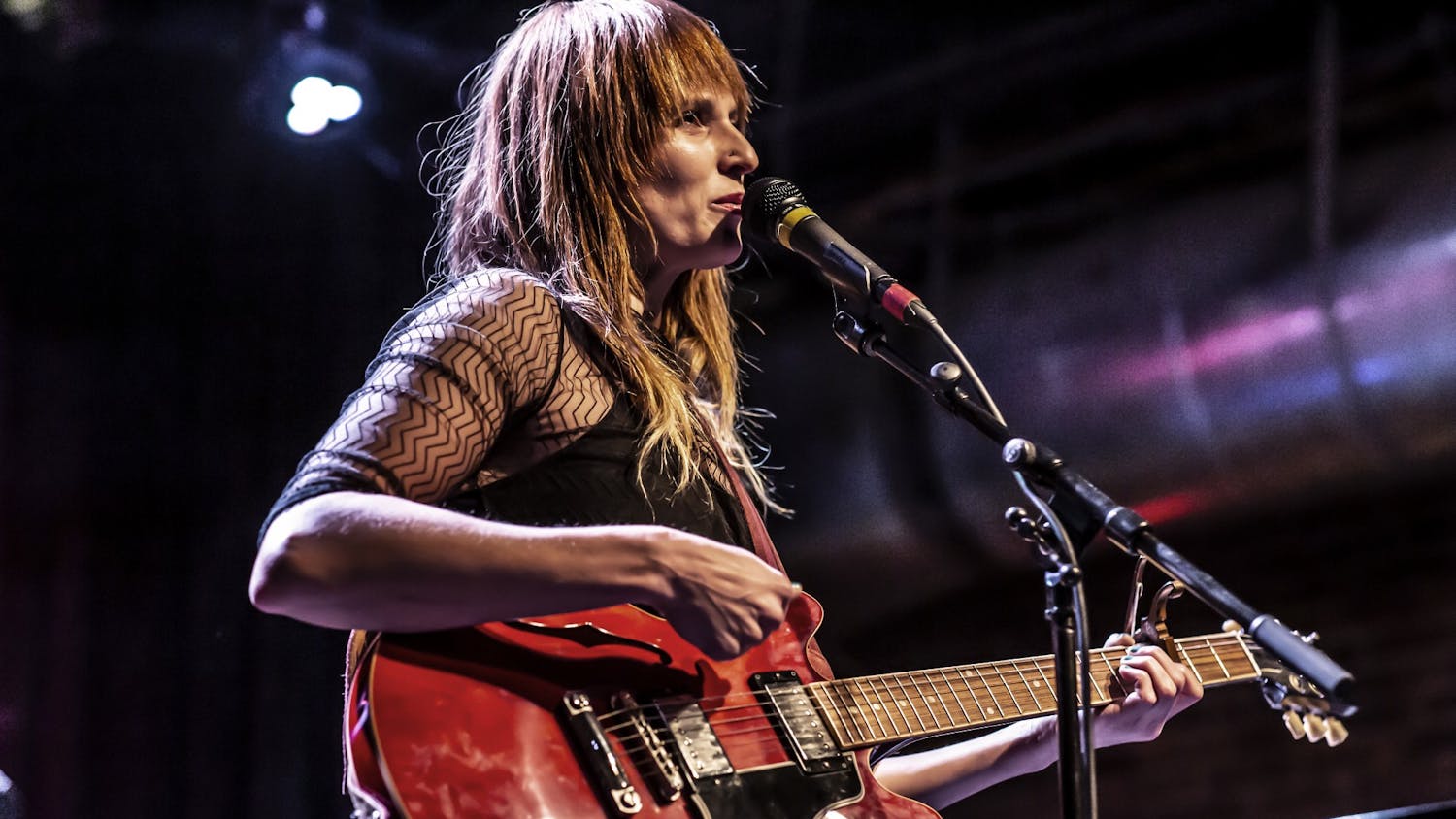Last month, Porter Robinson’s Worlds helped popular electronic music to take a step in the right direction, encouraging a shift in focus from the loud, formulated nature of big room dance music to an emphasis on meaningful and emotional songwriting. When he began writing Worlds, Robinson may not have always had ambitions of grandeur, but it was clear that he was on to something special. “All along, I knew I was going to write something deeply personal,” Robinson told me, regarding his songwriting process. However, the culmination of Robinson’s vision extends far beyond the album itself. Last Saturday, the Orpheum Theater was home to the Worlds Tour, a monumental production that brought the album to life more vividly and cohesively than I could have ever expected. “I definitely wanted it to feel like the most beautiful version of the music,” Robinson told me. “It was such a high-octane effort to try to get the show right aesthetically.”
One of the most important distinctions to be made is that Worlds is not to be misinterpreted as an EDM album, and the live show that accompanies it is as far from a rave as a high-budget electronic show could possibly be. “I think it has to do with the atmosphere,” Robinson said, regarding his growing distaste for EDM and the culture surrounding it. “[Music] is not meant to be treated as a party, and that’s what EDM is … When you’re writing music for DJs, there’s all these very functional things that you have to do to make it ‘work.’ I wanted it to be more about the listening experience.”
This put the extravagant nature of the live show into perspective for me. Especially when it comes to big room dance music, extravagant displays of light and color are nothing new. Visual displays used by most electronic artists feature lights and graphics that serve little purpose other than to add to the energy of their set and get a rise out of their audience, and this too often seems a bit one-dimensional. Meanwhile, the visual element of Porter Robinson’s Worlds Tour is every bit as creative and artistic as the album itself. “I definitely directed the whole thing. I put no less than 300 hours into it,” Robinson said when I asked him about his personal involvement with the aesthetic production of the show. “It was a massive, massive effort.”
Robinson’s visual show, ripe with recurring motifs of fantasy and adventure, paints a clear picture of the dystopian narrative hinted at by the album. Before I go any further, I will include an important disclaimer to any minimalists out there: If you are simply not a fan of high-budget productions, or if you tend to roll your eyes at the sight of smoke machines and a 30-foot-tall display screen, the Worlds Tour may not be for you. I understand that. I spent my younger years going to shows in basements and small venues, and at 15 years old I would have cringed at the idea of praising a show for its aesthetic concept and production value almost as much as for the music itself. But after seeing the creativity involved in Robinson’s new show, it would be unfair and naïve to dismiss its aesthetics as unimportant. The visual show that Robinson has created is not secondary to the music being performed or vice versa. Rather, the two work together to create a coherent multisensory experience, giving the audience a clearer look into Robinson’s vision than the music alone ever could.
Porter Robinson’s set began with a live rendition of “Sea Of Voices,” one of the more ambient and introspective songs from Worlds. A dark stage was lit only by a slow metronomic flicker of light in the center of the display, and then by the ASCII logo that Robinson has adopted. Robinson finished this introduction into his world with the eerie, isolated vocal melody as the stage returned to darkness. A direct transition into “Sad Machine,” which Robinson mentioned was one of his favorite songs to play live, sent the audience into a state of ecstatic bliss that would come and go throughout the show.
One of the interesting steps Robinson has taken in his new live show is his decision to play live keyboard melodies and even sing along with the vocals on his songs. “I’m not even very good at either,” he admitted to me modestly. “I don’t have those Sam Smith pipes, but I try to make it work for the sake of the show.” “Sad Machine” was the perfect outlet for Robinson to showcase this element of his show, adding a personal touch to his performance, and seemingly allowing him to feel a stronger emotional connection to his songs onstage. “There’s lots of cool moments where I can change the chord progression because I have control over that,” Robinson told me. “There’s some sections that have significantly changed from night to night, depending on how I play it live. Sometimes it does set an emotional atmosphere and I get really into it.”
Interestingly enough, Robinson’s set included quite a few older songs, which were vastly different in style from his Worlds material. His next two songs, “Easy” and “Unison,” are high-energy dance tunes that managed to bring the Orpheum to a higher and higher energy level without distracting from the emotional depth of the show. Throughout these songs (and the set as a whole), Robinson transitioned seamlessly from one song to the next, and hardly said a word to the crowd.
This led to a stark contrast when Robinson transitioned from these fun dance anthems into his chaotic, menacing live rendition of “Fresh Static Snow.” Robinson beat down on a drum pad intensely as an ear-splitting, distorted bass line rang out, and images of a demonic-looking beast took over his visual display. The vague dystopian narrative present in the album, amplified by his live show, featured recurring themes of good and evil, and images of this demonic being reappeared throughout the show to evoke feelings of evil and danger. The introduction of this motif reminded me of one of Robinson’s grievances with EDM music. “[EDM] focuses on being this fun thing always. That wasn’t my goal,” he explained. In my opinion, Robinson boldly separates himself from the feel-good EDM prototype by embracing these feelings of fear and terror. A great artist has the potential to evoke an entire spectrum of human emotion. In the same way that a good horror movie keeps us on the edge of our seats, Robinson invited his audience to step out of their comfort zone and find beauty in the emotions that are too often avoided.
As the show progressed, Robinson ultimately played almost every song from Worlds, most of them altered from their album version for the live show. Robinson’s performance of “Flicker” was among the first to highlight the immense influence of Japanese art on Robinson’s music as well as his visual display. Anime characters appeared on screen periodically, and the emotional journey evoked by Robinson’s music was chronicled by 16-bit video game-style animations that furthered his recurring dissonance between themes of good and evil. High-energy breaks were balanced by ambient, beautiful melodies in songs such as “Lionhearted,” “Natural Light” and “Hear the Bells.”
This contrast was further illuminated by “Fellow Feeling,” in which a rising and swelling orchestral intro is interrupted by an ugly, pounding breakdown, seen by some as Robinson’s ironic caricature of heavy dance music. “I guess it may have started as a tongue-in-cheek thing,” Robinson said about the song. “But it doesn’t sound like big room dance music to me at all actually… In the context of that song, it’s definitely a contrast against the prettier melody, but I don’t only see mockery in that song.”
This contrast continued as Robinson closed his set with “Goodbye to a World,” the final song on the album. The song featured delicate and slow-building melodies alongside an energetic yet emotionally powerful dance break. During this song, the 16-bit narrative onscreen behind Robinson came to a bittersweet conclusion as our nameless protagonist arrives at a shocking truth behind the evil forces at work in his reality. The show closed with a robotic vocal melody, growing increasingly distorted and broken, leaving the audience with a perfectly unresolved sense of anticipation as Robinson left the stage.
Of course, an encore was inevitable. Robinson returned to the stage to perform “Language,” a big room-style track from Robinson’s earlier days as an EDM producer. Given his pronounced distaste for the creative saturation of high-octane dance music, it was interesting that he chose this song to end the night. Perhaps he simply wanted to include this fan favorite, but didn’t want to send mixed signals by including it in his main set. I don’t see his inclusion of this track as a contradiction of his own words for the same reason that I wouldn’t criticize him for the high-energy dance breaks on the album itself. On songs like “Goodbye to a World,” “Fellow Feeling” and “Language,” Robinson makes it clear that while his distaste for EDM stems from a lack of creativity that plagues the genre, he does not condemn dance music altogether. He shows us that it is possible for music to be danceable and beautiful at the same time.
Hopefully, this notion will inspire others to think the same way. “My message is far from that EDM is bad or that party music is bad or that it shouldn’t exist,” Robinson said when I asked if he might return to playing EDM festivals in the future. “I’m not closed off to the idea of doing EDM festivals. I just felt that this year, I wanted to send a clear signal about the direction of my shows.”
Porter Robinson is not trying to change the world. However, I think that the emotion and creativity that he has brought to his music and his live show is a step in the right direction for mainstream electronic music. Robinson set out to write exactly the album that he felt he needed to write, despite what his fans may have wanted, and I think he deserves a lot of respect for sticking to his vision so cohesively. “I think it’s critical if you’re making any kind of music or art to keep the reception out of your mind while you’re writing,” Robinson told me. “Thinking about the reception is an easy way to lose the path and write music disingenuously. Even my own fans, you have to not think about. You have to be a leader as a creator. I felt pretty sure that there would be some backlash, but I didn’t really worry about it.”





